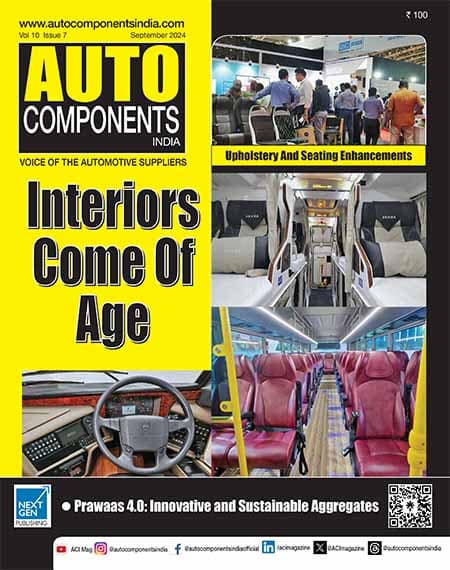Text: J Srikant
Industry will return to 4-6% growth after falling by 2.1% in FY2014
Trailing the revenue trajectory of the auto industry, the auto component industry too recorded its first revenue de-growth in over a decade, falling by 2.1% in the financial year 2013-14. Auto Component Manufacturers Association (ACMA) reported that the component industry has recorded a revenue of Rs 2,11,700 crore in FY 2013-14 as compared to Rs 2,16,000 crore in FY 2012-13.
“The last fiscal has been one of the most challenging for the automotive industry in India; flagging vehicle sales, high capital costs, high interest rates, currency fluctuations and slowing down of investment in manufacturing, have adversely impacted the growth of the auto component industry,” said Harish Lakshman, President, ACMA. However, he added that the effects seem to have bottomed out and he expects the industry to climb up to 4-6% growth in the current fiscal year.
Industry EBITDA (Earnings before Interest, Taxes, Depreciation and Amortisation) has been down from 10% to 12%. This figure is based on the 100 listed companies that ACMA tracks.
Passenger vehicles accounted for 46% of the total auto component supply. Two-wheeler segment, which was the only segment that performed well during the last year, stood at 21%; CV segment, tractors, and three-wheelers contributed 15%, 7% and 5% respectively to the revenue of the auto component industry.
A marked difference in the component industry from a decade ago has been the shift towards supplying directly to OEMs from relying heavily on the export aftermarket. The ratio between OEM sales to aftermarket sales a decade ago was around 20:80, which has over the years reversed, with 80% sales now happening directly to OEMs. This shows the increase in confidence of OEMs on the Indian auto component industry.
The below-par domestic performance was compensated to a certain extent by better export revenue which rose 16.7% to Rs 61,400 crore. The US continued to be the top export destination cornering nearly 21% exports, followed by Germany, UK and Turkey. Lakshman said that as long Indian currency exchange rate is around Rs 57 to the dollar and above, it keeps the Indian component industry competitive.
Pointing out reasons for the inspiring export performance, he said “The appreciation of Chinese currency coupled with their own market factors, has led to many MNCs looking towards India as an option for buying parts.”
Top auto component exports included hydraulic power steering systems & steering gear systems and parts, gear boxes and parts, wheels and components for construction & earth moving equipment, gas compressors, engine crank shafts, spark ignition systems, etc. The imports remain an area of concern for the industry as the trade deficit has continued to remain high, although there has been a drop from Rs 21,800 crore to Rs 15,700 crore in deficit.
China is the largest importer for India with 21% of the imports coming from there. However, exports to China are minimal. ACMA is looking at different options on how to rectify this trade imbalance by improving exports and reducing imports. Lakshman also pointed out that the various FTAs (free trade agreement) India has signed with different countries are not in favour of the component industry. “Thailand is the classic example of how FTAs have had a negative impact on the industry. Our trade deficit has increased with Thailand post FTA. We are now engaging with the government as to how we can address these concern areas.”
Expectedly, even capital investment by auto component manufacturers saw a sharp dip. Compared to last year’s Rs 6,900 crore – Rs 9,500 crore capex, FY 2013-14 saw only Rs 3,200 crore – Rs 4,400 crore. Lakshman said that most of the component manufacturers, except for some who primarily supply to two-wheeler OEMs, are sitting on excess capacity.
ACMA Vice President, Ramesh Suri said that power and infrastructure are a concern and if these issues are taken care of, the future is bright for the industry.“With the recent announcement of the Union Budget, the Government has taken a pragmatic approach of encouraging the MSMEs and investing in social and infrastructure sectors. We expect the new government to provide an environment conducive for growth and reviving the investment climate particularly in the automotive sector.”
There is also a renewed pitch to increase the skill sets available to the auto component industry, both at the managerial level and for shop floor workers. ACMA, in collaboration with SIAM and National Skill Development Council, has set up Automotive Skill Development Council which is working towards the goal of training 20 million people by 2020. ACMA also called for labour reforms, which have not been touched upon in the last 10 years, to tackle the frequent labour strikes which have also played a role in the de-growth story.
Lakshman said that one of the main challenges recognised by ACMA is the poor spending on R&D by Indian auto component manufacturers, which is nowhere close to the spending by western counterparts. Indian companies spend only about 1% of the revenue towards R&D as compared to 3-5% in Germany. There are also technical collaborations with Indian and foreign universities like Fraunhoffer University and MIT to help companies improve R&D.
BOX
Subros Chief is the next ACMA President
Ramesh Suri, Chairman of Subros Limited will be the next President of Automotive Component Manufacturers Association of India (ACMA). He will succeed Harish Lakshman of the Rane Group. Currently serving as Vice president of the apex body, Ramesh Suri will take over his new role during the annual general body meeting which is likely to be held in September. Earlier, Suri has been the Chairman of ACMA, Northern Region and Vice Chairman of CII, Uttar Pradesh State Council.













